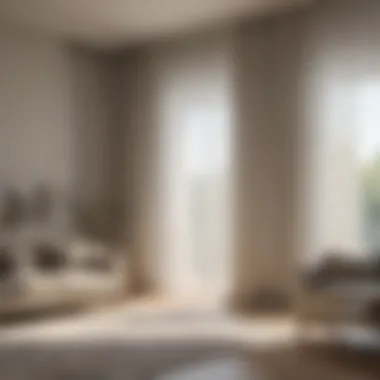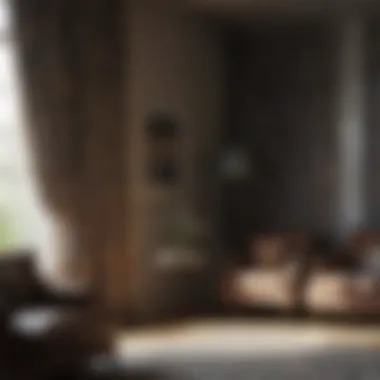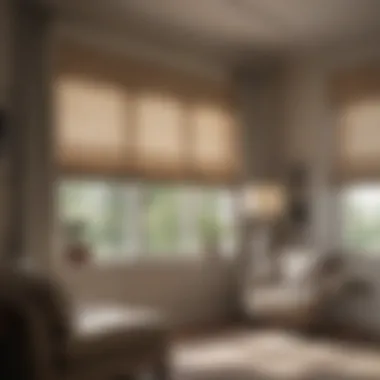Choosing the Best Curtains for Your Living Room


Intro
Choosing the right curtains for your living room is a decision that transcends mere aesthetics; it encompasses functionality, ambiance, and personal style. Curtains can transform a space, acting as both a decorative element and a practical solution for light control and privacy. Given the variety of fabric types, styles, and colors available, the selection process can be overwhelming. This article aims to demystify the options and offer guidance that balances beauty and utility.
Design Inspirations
Trending Styles
When considering curtains, it's important to stay updated on current trends. Popular styles often reflect a blend of contemporary design with timeless traditions. Options range from minimalistic sheer panels to sumptuous, heavy drapes that evoke a feeling of luxury.
- Sheer Curtains: These add elegance and allow natural light to cascade into your living room. They are ideal for a soft, airy look, especially in sun-drenched areas.
- Blackout Curtains: Best suited for those who prioritize privacy and light control, blackout curtains can create a cozy, intimate atmosphere while also improving energy efficiency.
- Layered Curtains: Combining sheer and black-out materials offers flexibility, allowing homeowners to adapt their ambient light levels to their mood or time of day.
Each option presents distinct advantages, catering to varied tastes.
Color Palettes
The color of your curtains can significantly influence the overall feel of your living room. Consider your existing decor and how these hues will work in harmony with other elements.
- Neutrals: Shades like beige, gray, or ivory are versatile and usually blend well with most furniture styles.
- Bold Colors: Vibrant hues such as deep blue or rich green can serve as focal points, drawing the eye and adding personality to the space.
- Patterns: Geometric designs or floral prints can introduce visual interest and bring character.
Selecting the right colors involves understanding their impact on room dynamics and how they resonate with the atmosphere you want to create.
"Curtains are not merely decorative; they shape the ambiance, define spaces, and even dictate moods."
Maintenance and Upkeep
Seasonal Maintenance Checklist
To preserve the look and function of your curtains, a proactive approach to maintenance is crucial.
- Spring: Check for any signs of wear or fading that may have occurred over the winter. Consider a deep clean, especially for heavier fabrics.
- Summer: Light and airy options can be washed lightly to remove dust and allergens.
- Autumn: Prepare for the upcoming winter by repairing any damage and ensuring that your curtains effectively block out cold drafts.
- Winter: Regularly check for moisture accumulation, especially if your living room is susceptible to heating issues.
Cleaning and Organization Tips
Keeping your curtains clean enhances their longevity and keeps your living space fresh. Regular washing or steaming based on the fabric is essential. Reference the specific care instructions for your curtain fabric to avoid damage. Here are some organizational tips:
- Routine Washing: Depending on the fabric, curtains might need to be washed every few months. Always refer to the care label for specific instructions.
- Storage: When changing curtains seasonally, use breathable garment bags to keep them safe from dust and pests.
Making informed choices about the maintenance of your curtains can prevent deterioration and ensure they continue to beautify your living space for years to come.
Understanding Curtain Functionality
The selection of curtains is more than just an aesthetic endeavor; it serves multiple practical purposes in a home. Understanding the functionality of curtains is key in creating an atmosphere that is both inviting and efficient. Curtains control light, enhance privacy, and contribute to insulation, all crucial aspects that influence overall living conditions. Each of these elements requires careful consideration to achieve an optimal balance of beauty and utility.
As homeowners or design enthusiasts set out to choose curtains, it is essential to remember that these elements fulfill not only a decorative role but also impact the comfort and energy efficiency of a living space.
The Role of Curtains in Interior Design
Curtains can radically alter the look and feel of a room. They frame windows and serve as a focal point while harmonizing with existing interior design themes. The right curtains can complement furniture styles, color schemes, and materials used in the room, providing a coherent design story.
For instance, sheer curtains offer a light and airy feel, while heavy drapes can create a sense of grandeur. Textures and colors also play a vital role; softer tones can make a room seem larger, while bold colors can enhance it visually. The selection should align with the desired ambiance of the living room, addressing both taste and functionality to curate the ideal environment.
Light Control and Privacy
Curtains can manage natural light effectively, allowing homeowners to regulate the intensity and quality of illumination within the space. This aspect is particularly significant in living rooms where light from the sun can be overwhelming during certain times of the day.
By selecting curtains with varying opacity, one can achieve different levels of light control. For instance, blackout curtains block nearly all light, making them suitable for media rooms or for those who wish to take midday naps. In contrast, sheer curtains allow soft light to filter through, brightening the space while providing little in the way of privacy.
Privacy is another layer intertwined with light control. Properly chosen curtains can guard against prying eyes, creating a tranquil atmosphere. The mix or layering of different curtain types can enhance both light control and privacy, making this aspect essential for any well-planned living area.
Insulation and Energy Efficiency
Curtains play an understated yet critical role in the insulation of a home. Many do not realize that the choice of curtains can impact indoor temperatures and energy bills. Thermal insulated curtains are designed to conserve energy by blocking heat during the winter and reflecting sunlight during summer. These curtains can significantly reduce heating and cooling costs.
Investing in adequate curtains that enhance insulation measures the comfort of the living space. It also contributes positively to the overall energy efficiency of the home, creating a more sustainable living environment. In regions with extreme weather conditions, this aspect becomes particularly relevant, impacting both comfort and utility costs.
Consider choosing thermal curtains if energy efficiency is a priority. They can save on heating and cooling, which benefits both comfort and your wallet.
Evaluating Different Curtain Types


Evaluating the various types of curtains is crucial when selecting the right options for your living room. Each curtain type serves distinct functions and impacts the aesthetics of the space. When homeowners and design enthusiasts consider these options, they often weigh factors like light control, privacy, and style. Furthermore, each type has its own advantages, suitable for different needs and environments.
Sheer Curtains
Sheer curtains are known for their lightweight and translucent fabric. They are often chosen because they allow natural light to filter in while creating a sense of openness and airiness in a room. They add a soft, delicate touch to the decor, making them a popular choice in modern and traditional settings. One must consider their location carefully, as they offer limited privacy, especially at night.
Sheer curtains can beautifully diffuse sunlight, enhancing the room's ambiance while protecting interiors from UV damage.
Homeowners might combine sheer curtains with heavier drapes for added privacy and versatility. This allows one to control light levels while still enjoying the benefits of natural illumination.
Blackout Curtains
Blackout curtains serve a specific purpose: to block out all incoming light. This makes them ideal for bedrooms or media rooms where darkness is a priority. They are typically made from thick, opaque materials designed to block sunlight effectively.
The benefits of blackout curtains extend beyond mere light control. They often provide improved temperature regulation by preventing heat loss during colder months and blocking heat in summer. Overall, they can help lower energy bills by reducing reliance on heating and cooling systems.
Thermal Insulated Curtains
Thermal insulated curtains are designed to offer the same benefits as blackout curtains, with an additional focus on energy efficiency. These curtains have a special lining that traps air, creating an insulating layer. This helps maintain room temperature, making them ideal in homes where energy efficiency is important.
Many homeowners appreciate thermal insulated curtains for their dual functionality: they help keep the room warm during winter and cool in the summer. This can significantly contribute to enhanced comfort and reduced energy costs.
Lined Curtains
Lined curtains come with an additional layer of fabric sewn behind the main fabric. This lining can serve multiple purposes, including light blockage, added insulation, and enhanced durability. While they may not fully block out light, lined curtains can reduce glare and provide a softer light in the room.
Another key benefit of lined curtains is their increased lifespan. The lining helps protect the outer fabric from sun damage and everyday wear and tear. This makes them a wise choice for high-traffic areas, ensuring that the curtains maintain their beauty over time.
Layered or Double Curtains
Layered or double curtains refer to the technique of using two different types of curtains simultaneously. This style offers both aesthetic appeal and functional benefits. For example, one might use sheer curtains for light filtration and blackout curtains to control privacy and light levels at night.
Using layered curtains also allows homeowners to experiment with colors and patterns. This method can add visual interest to the living space, making it feel warmer and more inviting. It is essential to plan the layering carefully, ensuring that the different fabrics complement one another without appearing disjointed.
Material Considerations
When selecting curtains for a living room, the choice of material is a pivotal aspect that affects not only aesthetics but also functionality. Different materials offer various advantages, including how well they handle light, their durability, and ease of maintenance. Understanding the characteristics of fabric options helps homeowners make informed decisions, ensuring that the curtains complement their living space while serving practical purposes.
Natural Fabrics
Natural fabrics such as cotton, linen, and silk are popular choices for curtains. These materials are usually breathable and offer a soft, inviting look.
- Cotton: Cotton curtains are versatile and easy to care for. They are available in numerous colors and patterns, making it simple to find a match for any decor. Cotton also holds dye well, which enhances the vibrancy of colors.
- Linen: Linen has a slightly coarse texture, providing a more casual and relaxed appearance. It drapes beautifully, allowing for an elegant look when hung. However, linen may wrinkle easily and might require more maintenance to keep it looking its best.
- Silk: Silk adds a touch of luxury. It has a natural sheen that elevates the decor. However, silk curtains can be more delicate. They require careful cleaning and may not handle direct sunlight well without fading.
Natural fabrics can be a more environmentally friendly option, often utilizing less harmful chemicals during production. They contribute to a warm and inviting atmosphere but may require more upkeep over time.
Synthetic Fabrics
Synthetic fabrics like polyester, nylon, or acrylic offer advantages that make them viable options for living room curtains. These materials tend to be more durable and resistant to fading and staining, ideal for high-traffic areas.
- Polyester: Polyester curtains are known for their resilience. They resist wrinkling, shrinking, and fading, making them a low-maintenance choice. Additionally, their affordability can make them attractive for homeowners on a budget.
- Nylon: Often used in blends, nylon is known for its strength and often provides a silky texture. It does well in conditions where moisture may be a concern.
- Acrylic: Acrylic is lightweight and often used for its resistance to fading and mildew. This material is less likely to require spot cleaning than natural fabrics, making it pragmatic.
While synthetic fabrics might lack the natural feel of their counterparts, they provide an opportunity for a more practical solution. When well cared for, synthetic curtains can effectively enhance the decor while remaining functional.
Blended Fabrics
Blended fabrics combine natural and synthetic fibers to create curtains that offer the best of both worlds. These materials often provide improved durability while retaining softness. For example, cotton-polyester blends can be a wonderful choice.
- Balance of Qualities: Blends typically aim to reduce the drawbacks of each individual fabric. A cotton-polyester blend may provide a soft touch with durability, while reducing potential shrinkage or wrinkling issues.
- Versatility: Blended fabrics can come in various textures and patterns, giving homeowners ample options to fit different styles.
- Cost-effectiveness: Often, blended fabrics are more affordable than pure natural options, appealing to budget-conscious shoppers without sacrificing quality.
Choosing fabrics wisely is essential for achieving curtains that are not just visually appealing but also practical. Homeowners should consider their lifestyle and the specific needs of their living room when selecting fabric types.
Curtain Styles to Consider
When choosing curtains for your living room, the style plays a pivotal role. Different styles will convey distinct aesthetics, evoke various moods, and contribute to the overall character of the space. Selecting the right style is not just about looks. It contextualizes your decorative choices, merges with other design elements, and impacts functionality. Understanding style helps create harmony within your home environment.
Classic Styles
Classic styles are timeless and evoke a sense of elegance and sophistication. They often embrace traditional patterns and rich fabrics, incorporating materials like silk, velvet, or brocade. Favorable colors range from deep hues to subtle pastels, each enhancing the beauty of your living space.
One common type of classic curtain is the pleated drape. They offer a tailored look that fits formal living rooms well. Rod-pocket curtains are another option—easy to install and enhance the vintage feel. These styles pair well with ornate furniture and detailed architecture.


Key benefits of classic styles include:
- Timeless beauty: They never go out of style.
- Versatile fit: Adaptable to various interior designs.
- Luxury appeal: Quality fabrics can elevate the ambiance.
Modern and Minimalistic
In contrast, modern and minimalistic curtains focus on clean lines and simplicity. Fabrics used in these styles tend to have neutral tones or bold graphics but are rarely excessively ornate. The emphasis is on form and function, enhancing spaces without overwhelming them.
For example, sheer panels or simple shades are common in such designs. Through these curtains, natural light can flow freely while still offering some privacy. The advantages of modern styles include:
- Simplicity: Create an uncluttered appearance in your space.
- Light-weight: Typically, use lighter materials for easy handling.
- Functional design: Often made for ease of use, they blend into the environment.
Eclectic and Bohemian
Eclectic and Bohemian styles embrace a free-spirited aesthetic, combining various cultures, patterns, and colors. These curtains often showcase vibrant hues and diverse textures, making a bold statement in any living room.
They might include embroidered fabrics, patterned textiles, or vintage finds that highlight uniqueness. The eclectic look encourages mixing and matching elements to make a personalized statement. Some aspects to consider:
- Expressiveness: Allows for creative choices reflecting individual style.
- Colorful variety: Perfect for those who love vibrant interiors.
- Layering options: Various curtains can be layered to enhance texture and depth.
Rustic and Farmhouse
Rustic and farmhouse styles are characterized by warmth and comfort. They usually utilize natural materials, such as linen or cotton, often in muted tones and simple patterns like checks or stripes. This style aligns with a cozy and inviting atmosphere.
For instance, a set of light-colored, unlined curtains can blend well with distressed wood furnishings, creating a harmonious environment. Key features of rustic farmhouse styles include:
- Cozy appeal: Perfect for creating a relaxing environment.
- Natural materials: Emphasize sustainability and comfort.
- Versatile: Suitable for both modern and traditional interiors.
Each curtain style has strengths and suitability depending on the overall theme and purpose of the room. Homeowners should match style choices to their personal aesthetics and everyday needs.
Measuring for Curtains
Measuring for curtains is crucial for achieving the desired look and functionality in your living room. Not only does accurate measurement ensure that the curtains fit properly, but it also enhances the overall aesthetic appeal of the space. Proper measurements allow you to avoid common pitfalls, such as curtains that are too short or too long, impacting both privacy and light control. Additionally, the right fit contributes to the insulation properties of the curtains. Here are the key aspects to keep in mind when measuring.
Window Measurements
Getting the window measurements right is the starting point in the process of selecting curtains. First, identify the type of window treatment you plan to use. For instance, if you want the curtain rod to sit above the window frame, you need to take measurements from the top of the frame to the bottom. This distance dictates the overall drop of the curtains.
When measuring width, it's advisable to add several inches to both sides of the window frame if you want the curtains to extend beyond the window. This technique creates an illusion of larger windows and helps in effective light control. Use a metal measuring tape for accuracy and write down each measurement carefully. Measure at least twice to avoid errors.
Choosing Length and Width
The choice of length and width in curtains can significantly influence the room’s ambiance. When it comes to length, you have a few options: floor-length, sill-length, or anywhere in between. Floor-length curtains may enhance elegance and create a dramatic look, while sill-length curtains are more casual. Consider the function of the living room when determining length; this will guide your decision towards practicality as well as style.
For width, consider the fullness of the curtains. A general rule is to have curtains that are 1.5 to 2 times the width of the window. This gives the curtains a nice, full look when drawn closed, adding to the aesthetic appeal.
Accurate measurement is the foundation of successful curtain installation. Improper measurements can lead to wasted time and financial resources.
Color and Pattern Choices
Selecting the right color and pattern for your curtains is essential in achieving a harmonious and aesthetically pleasing living room. Curtains are not just functional items; they significantly contribute to the overall design of a space. The right choice of color can influence the mood of the room, while patterns and prints can add character and style. Understanding their roles helps in making an informed decision that reflects personal taste and complements interior decor.
Solid Colors
Solid colors can instill a sense of simplicity and elegance in a room. They offer a versatile backdrop that allows other design elements to shine. Choosing a single color can help to achieve a cohesive look. Some considerations when selecting solid-colored curtains include:
- Impact on Space: Lighter hues can make a room feel spacious and airy, while darker shades can add warmth and intimacy.
- Color Psychology: Colors evoke emotions. For example, blues can impart tranquility, greens can create a fresh ambiance, and yellows can introduce vibrancy.
- Coordination with Decor: Ensure the chosen color harmonizes with furniture and wall colors. This creates a balance throughout the room.
Solid color curtains can also serve as a tool for defining the space. They can seamlessly blend in or stand out depending on the surrounding colors.
Patterns and Prints
Patterns and prints add visual interest and a unique flair to your living room. They can be a focal point or enhance the overall design without overwhelming it. When considering patterns and prints, think about the following aspects:
- Style Expression: Patterns convey personality and style. Stripes can evoke a nautical theme, florals may bring a romantic feel, while geometric designs can suggest modernity.
- Mix and Match: Combining patterned curtains with other patterned decor can create dynamism. However, it’s essential to vary the scale and type of patterns to avoid clashing.
- Room Functionality: In a vibrant living room, playful prints might suit well, while in a formal setting, a subtle damask or monochrome pattern may be more appropriate.
In choosing patterns, consider the size of the room and the existing design elements. Large patterns may overwhelm a small space, while tiny prints could get lost in a larger area.
"The right color and pattern choices not only elevate the beauty of your living room but also enhance how you feel in the space. Their impact is profound yet often understated."
Maintenance and Care of Curtains


Maintaining and caring for curtains is crucial for prolonging their life and keeping them looking their best. Curtains serve not only to decorate your living space, but they also contribute actively to the comfort of your home by helping with insulation and light control. With appropriate care, curtains can retain their color, texture, and overall appeal for years. Ignoring maintenance can lead to dust accumulation, fabric wear, and loss of functionality.
Additionally, clean curtains enhance indoor air quality. A well-kept curtain acts as a filter for air pollutants, dust, and allergens that may enter your home. Regular maintenance prevents these particles from settling and causing health concerns, especially for those who suffer from allergies or respiratory issues.
In summary, focusing on appropriate maintenance practices not only preserves the aesthetic of your curtains but also ensures a healthier living environment.
Cleaning Methods
There are several cleaning methods for curtains, and the choice depends on the fabric type and instructions provided by the manufacturer. Here are the most common methods:
- Vacuuming: Use a vacuum with a brush attachment to remove dust and debris from curtains. This should be a regular practice, especially for sheer or delicate fabrics.
- Washing: Many curtains are machine washable. Check the care label for temperature settings and wash cycle recommendations. Generally, a gentle cycle with mild detergent is advisable.
- Dry cleaning: Some fabrics require dry cleaning. If the care label indicates this, take them to a professional cleaner to prevent damage.
- Spot cleaning: For minor spills or stains, spot cleaning is effective. Use a damp cloth and a little soap to gently dab the area, being careful not to rub and damage the fabric.
Adhering to these practices can maintain the integrity and appearance of your curtains.
Stain Removal Techniques
Stains are inevitable, but knowing the right techniques can help tackle them effectively. Here are tips for removing common stains from curtains:
- Water stains: Blot the stain gently with a clean cloth dipped in cool water. Avoid saturating the fabric, as this can create further damage.
- Grease stains: Sprinkle baking soda on the affected area and let it sit for several minutes to absorb the grease. Afterward, gently brush it off.
- Ink or pen stains: Apply rubbing alcohol to a cotton ball and blot the stain. Avoid rubbing, as this could spread the ink further.
- Food and drink spills: For food or drinks, mix warm water with a small amount of dish soap. Dab the solution onto the stain with a cloth, then blot with water to rinse.
Proper stain removal depends on immediate action. The sooner you address the stain, the better the chances of complete removal.
Installation Options
When selecting curtains for your living room, the installation options are just as important as the fabric and style you choose. The way you hang your curtains can significantly influence both functionality and aesthetics. Understanding different installation methods allows you to customize your living space better. A well-installed curtain enhances the room's overall look while serving practical needs like light control and privacy.
When choosing installation methods, homeowners need to consider factors like the type of windows, existing decor, and desired functionality. Proper installation not only improves the curtains' appearance but also ensures their longevity. Here are the key elements to think about regarding installation options:
- Easy Access: Consider how frequently you will open or close the curtains. You may prefer a method that allows for effortless access.
- Room Size: The height of the ceiling and size of the window can affect the choice of hanging techniques. Taller ceilings can benefit from high-hanging methods for an elongated look.
- Light Control: Depending on your light control needs, different hanging placements may work better—for example, mounting curtains wider than the window frame allows more light into the room when the curtains are open.
"The right installation can transform ordinary curtains into a key aspect of your living room's interior design."
Hanging Techniques
The hanging technique of curtains varies widely, and each method has its unique benefits. The typical options include:
- Rod Pocket: A simple and classic way to hang curtains. The fabric slides onto a curtain rod through a sewn pocket at the top.
- Grommet Top: Features metal rings that allow smooth movement along the rod. This design gives a sleek and modern finish.
- Tab Top: Loops of fabric at the top attach to the rod. This technique is often casual and suits relaxed settings well.
- Pleated: This technique uses pleats to create a tailored look, making it ideal for more formal spaces.
Choosing the right technique can enhance your living room's character and complement your decor while ensuring that the curtains are practical for your needs.
Hardware Selection
Selecting hardware for your curtains is a vital step in the installation process. The right hardware not only supports the curtains but also adds to the aesthetic appeal. Here are important considerations regarding hardware selection:
- Rod Material: Options range from wood to metal, and the choice influences durability and style. Wooden rods can evoke a warm, traditional feel, while metal rods often lend a contemporary look.
- Brackets: Ensure the brackets that hold the curtain rod are sturdy enough to support the weight of your curtains. The style and finish should coordinate with other elements in the room.
- Finials: These decorative ends of the rod can act as a finishing touch, reflecting your style. Choose ones that align with your overall room decor, whether rustic, modern, or elegant.
- Tiebacks and Holdbacks: These accessories help secure the curtains when open. They can be functional and decorative, adding another layer of style to your living room.
By carefully selecting both hanging techniques and hardware, you can achieve a seamless integration of curtains into your living room's overall design. This attention to detail emphasizes your commitment to creating a well-thought-out living space.
Budget Considerations
When it comes to selecting curtains for your living room, budget considerations play an essential role in the decision-making process. A thoughtful budget can help you evaluate options that align with your financial capacity while still achieving your aesthetic goals. Understanding where to allocate funds appropriately can enhance both the visual appeal and the functionality of your curtains.
Setting a budget ensures that you do not overspend on a furnishing that, while important, should also complement the overall investment in your home. It allows for a more focused selection process, minimizing overwhelming choices and helping to prioritize what’s most critical based on your needs.
There are several key elements to consider when budgeting for curtains:
- Fabric Type: The material of the curtains can significantly affect the price. Natural fabrics, such as linen or silk, often come at a higher price than synthetic options like polyester. Common sense dictates that higher quality materials may yield better longevity and aesthetic appeal.
- Curtain Length and Size: Larger windows require more fabric and therefore increase overall cost. Measure your windows carefully to avoid unnecessary fabric purchases, as oversized or improperly fitted curtains can add unwanted expense.
- Styles and Features: Curtains with special features, such as blackout lining or thermal insulation, usually come at a premium. Consider whether these extra features align with your living room's needs and whether their costs can be justified.
- Installation Costs: Factor in expenses not only for the curtains themselves but also for hardware and installation. If you opt for custom drapes, labor costs may add to your budget.
By carefully assessing these cost variables, you can create a well-defined budget that enhances your overall experience and satisfaction with your chosen curtains.
Cost Variables
Various factors contribute to the overall cost of curtains. Recognizing these variables helps in making informed choices. Here are some common aspects to consider:
- Fabric Quality: As mentioned, the fabric type influences cost. Higher-quality materials tend to last longer but may require a larger investment.
- Curtain Types: Options like sheer curtains or thermal insulated curtains are priced differently. It is important to identify which specific type meets your needs.
- Length and Width: The dimensions of curtains affect pricing. Measure carefully to accurately calculate fabric needs and minimize waste.
- Customization: Custom-made curtains can greatly exceed the cost of ready-made options. Customization should only be considered if it adds significant value to your space.
Understanding these variables helps prioritize wants versus needs, guiding better financial decisions in your curtain selection process.
Where to Purchase
Selecting the right store or online platform for purchasing curtains is just as important as the budget itself. Here are some well-known options to consider:
- Home Depot: This retailer offers a range of functional and stylish curtains suitable for any living room design.
- Ikea: Known for budget-friendly options, Ikea provides a variety of styles, from contemporary to rustic.
- Wayfair: An online powerhouse with extensive selections, Wayfair is ideal for those wanting a vast array of styles and materials.
- Pottery Barn: If you are looking for higher quality and aesthetic appeal, Pottery Barn presents elegant options that cater to a more luxury-oriented clientele.
- Etsy: For unique, handmade curtains, Etsy provides a platform where you can often find one-of-a-kind designs.
Researching customer reviews and price comparisons from these sources will ensure you make smart choices. Each option has its strengths, allowing for flexible choices based on personal needs and budgets.
"Budget considerations are not merely about minimizing costs; they shape the selection process and ensure a match between beauty and practicality."







